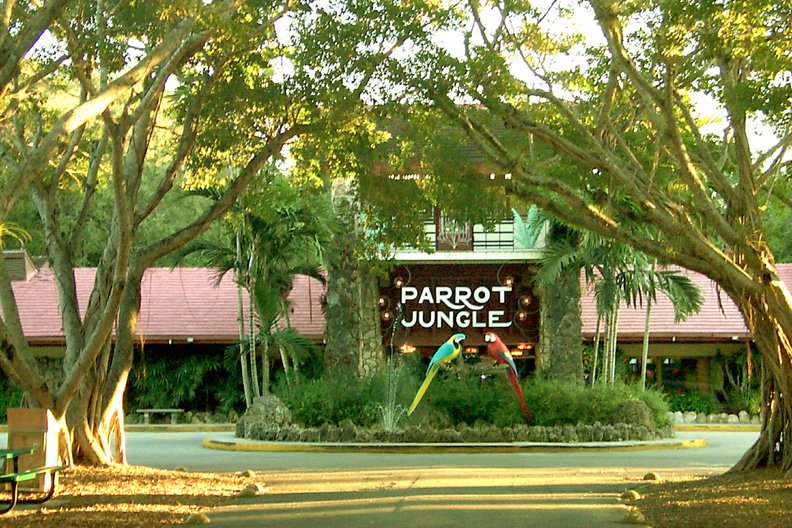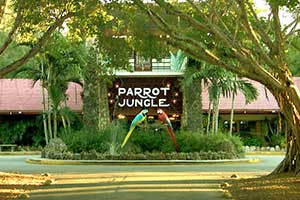
Composting at Parrot Jungle and Gardens

Biocycle Journal of Composting and Recycling, March 1996
For the last five years we have been licensed by the Department of Environmental Regulation Management (DERM) to run a minimum technology composting operation at Parrot Jungle and Gardens.
We are an accredited zoological institution and a botanical garden that has been in business since 1936. The park's 22 acres includes 14 acres of gardens, exhibits, and animal shows. The remainder of the property is utilized for overflow parking, a plant nursery, and a composting operation.
We compost 100 percent of everything organic that the Park produces except food waste. All of the finished compost is returned to the Park either as fill or utilized in our one-half acre plant nursery as the major constituent of our potting medium. Until we started a serious composting program we used to spend thousands of dollars a year in hauling fees. The purchase of top soil for the nursery and the Park would cost about $1,000 a year. We also had to maintain a trash pile on site which became a sensitive issue because of the expensive homes surrounding our Park.
Not all vegetation goes directly into the compost pile. We have a wood chipper that we run all tree branches and palm fronds through. Mulch is utilized extensively throughout the garden for top dressing. The mulch that is not suitable (i.e. some palm fronds have spines) goes directly into the compost pile.
We have many water features and when the aquatic plants become too numerous or they are no longer needed we harvest them and mix them into the compost pile.
The windrow is maintained with a front end loader. The pile is usually turned about once every two weeks and a sprinkler is used to add water when needed. Our maintenance schedule for the windrow is dictated by the weather. In Miami the weather is never consistent, it can rain for weeks and then be dry for a few more. We have never had an odor problem so the system obviously works.
We fill a 10 yard dumpster once a week with cardboard. Several years ago we tried an experiment with composting cardboard boxes. With DERM's approval, we mixed the flattened boxes with several yards of chipped Leucaena leucocephala. The mixture was placed within a pile of finished compost and watered. There were two control piles, one of just finished compost and the other just cardboard inside the compost. Within five weeks the first pile was almost 100 percent finished compost and this was done without turning. The cardboard in the other pile without the Leucaena had not even began to decompose. Whenever we get a large quantity of plant material with a high nitrogen content (i.e. Pistia or Eichhornia) we compost our cardboard.
Having access to the quantity and quality of compost that we produce has enhanced our Integrated Pest Management program. We now purchase less fertilizer because of the nutrients that the compost contains. We have reduced our reliance on fungicides and nematicides about 90 percent in the last five years.
We are now in the process of designing a new Park at another site. Space limitations dictate that we will not be able to dedicate one-half acre to a windrow operation. The cost benefits, the educational side of this type of operation, and the practical uses of compost in our garden is encouraging us to look at in-vessel or forced aeration systems.
In any business, being cost effective may mean the difference between success and failure. Sometimes its the nonglamorous items that need to be investigated.
Jeff Shimonski,
Director of Horticulture
Parrot Jungle and Gardens
The preceding article was originally submitted to "BIOCYCLE" to acquaint others involved with composting about the methods used at Parrot Jungle and Gardens (PJG) to recycle plant and animal refuse. Since the publication of this article the question has often been asked "What is the volume and weight of the organic waste produced per day, month, and year at PJG?". This is difficult to quantify unless we measured and weighted the waste produced at PJG every day and continued to weigh it as moisture evaporated over time until it was completely decomposed. This would become a very expensive and time consuming study.
One method of reasonably estimating the amount of waste produced would be to utilize data from existing natural sites in the tropics. Parrot Jungle and Gardens is a 22 acre site, with 14 of those acres dedicated to the actual park. The large amount of tropical plants that are grown in a natural setting and the location of the park itself could justify the use of this data. South Florida is located in a subtropical zone with the southern most city, Key West, about 50 miles north of the Tropic of Cancer. Sargent (1905) designated several major "tree regions" of Canada, the United States, and adjacent Mexico. The smallest of these tree regions in surface area was termed "Tropical Florida". This area lies below 26 degrees N latitude or just south of the city of Miami (PJG is located within this area). This designation seems appropriate, of the approximately 130 species of trees native to south Florida, 112 have an otherwise tropical distribution (Tomlinson 1980).
When hurricane Andrew passed through Miami in 1992 about 60% of the canopy trees at PJG were lost. Much of the Park was a native climax community at least as far as the canopy was concerned. The hardwood hammock was dominated by live oak (Quercus virginiana) and the cypress slough was a magnificent stand of bald cypress (Taxodium distichum) over 100 feet high. During the two years following the hurricane, the gardens were aggressively replanted and the extra sunlight was taken advantage of to increase the number of herbaceous tropical plant species. The constant irrigation and frequent fertilization of the gardens, which feature tropical plants in a natural setting, could place this site in the same category as a wet tropical rain forest where biomass production is concerned. (The use of finished compost to augment the thin layer of topsoil naturally found in the park is also utilized.) Since hurricane Andrew, the resulting vegetation corresponds to early secondary succession growth in a wet tropical forest, especially since many of the plants are considered "light gap colonizers".
Data already available in the literature should allow one to make a reasonable judgment as to the amount of waste produced at a garden site. The highest rates of litter production are in the tropics (Jordan 1983). It has been reported that, in general, a tropical forest produces about five tons of dry organic matter per hectare per year, whereas a temperate forest produces about one ton of dry organic matter per hectare per year (Golley 1983). These data and the determination of PJG as a tropical site should allow one to estimate the amount of dry organic matter produced would be approximately five tons per hectare per year.
©1996 Jeff Shimonski
Citations
Golley, Frank B., 1983. Decomposition, In: F.B. Golley (Editor), Ecosystems of the World, Tropical Rain Forest Ecosystems, Structure and Function. Elsevier Scientific Publishing Company, New York, pp. 157-166.
Jordan, C. F., 1983. Productivity of Tropical Rain Forest Ecosystems and the Implications for their Use as Future Wood and Energy Sources, In: F. B. Golley (Editor), Ecosystems of the World, Tropical Rain Forest Ecosystems, Structure and Function. Elsevier Scientific Publishing Company, New York, pp. 117-132.
Sargent, C. S., 1905. Manual of the trees of North America (exclusive of Mexico). Houghton, Mifflin Co., Boston and New York.
Tomlinson, P. B., 1980. The Biology of Trees Native to Tropical Florida. Harvard University Printing Office, Massachusetts.


 About Compost, Mulch & Tilth
About Compost, Mulch & Tilth The Lattice Stinkhorn, It’s Slimy and It’s Smelly
The Lattice Stinkhorn, It’s Slimy and It’s Smelly Relocating A Theme Park With A Compost Foundation
Relocating A Theme Park With A Compost Foundation How the use of Compost and Mulch has been an Important Component of a Successful Integrated Pest Management Program
How the use of Compost and Mulch has been an Important Component of a Successful Integrated Pest Management Program Composting at Parrot Jungle and Gardens
Composting at Parrot Jungle and Gardens